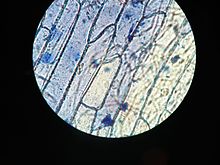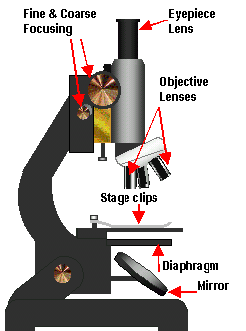School Science/How to prepare an onion cell slide
Tissue from an onion is a good first exercise in using the microscope and viewing plant cells. The cells are easily visible under a microscope and the preparation of a thin section is straight forward. An onion is made of layers, each separated by a thin skin or membrane. In this exercise, you will make a wet mount on a microscope slide and look at the cells of the onion membrane magnified by the high power, compound microscope.


dye, pin, onion membrane, slide, and cover slip

A simple student's microscope
Method edit
- First add a few drops of water or solution on the microscope slide to avoid dryness and wilting
- Take a small piece of onion and using tweezers, peel off the membrane from the underside (the rough side).
- Place the membrane flat on the surface of the slide.
- Add a drop of Iodine solution to the onion skin
- Using a pin, lower the thin glass cover slip or cover glass onto the slide. Make sure there are no air bubbles (Fig. 1).
- Make sure the lowest power objective lens (the shortest lens if there are several present) is in line with the optical tube, and the microscope light is turned on. Then place the prepared slide onto the stage of the microscope.
- Looking from the side (NOT through the eyepiece), lower the tube using the coarse focus knob until the end of the objective lens is just above the cover glass. Do this carefully so as not to crack the cover glass (and possibly damage the objective lens).
- Now look through the eyepiece and turn ONLY the smaller, fine focusing knob to move the optical tube upwards until an image comes into focus. The cells should look something like lizard skin.
- Swap the objective lens for a higher powered one so that you can see the cells at greater magnification. You should be able to make out a nucleus in each cell.
- Be very careful; these dyes can stain your skin and clothes. Could be dangerous if it is on you.
Proper use of the microscope - intended to prevent damage to the objective lenses - requires that the following techniques be followed:
- Never use the coarse focus knob while looking through the eyepiece. The point of focus will be very near the cover glass. Looking from the side, lower the optical tube until the objective lens is as close as you can get it to the cover glass without actually touching it. Starting with the low power objective lens is the fastest way to achieve proper focus.
- Initially, slowly focus back (turn the fine focus knob to raise the optical tube) while looking through the eyepiece. Once the specimen comes into focus, you can make fine adjustments up or down with the fine focus knob without fear of damaging the slide or the microscope.
- If the specimen does not focus, raise the tube a little with the coarse focus knob and attempt to focus again with the fine focus knob. Once the object is in focus, switching objective lenses should be possible without any further coarse adjustments.